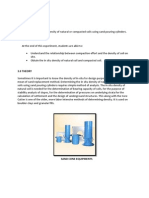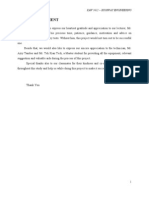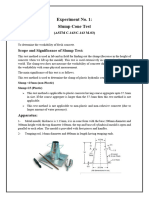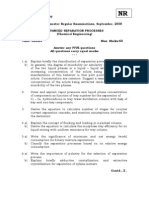Standard Proctor Test - Lab Manual
Uploaded by
mmStandard Proctor Test - Lab Manual
Uploaded by
mmINDIAN INSTITUTE OF TECHNOLOGY GANDHINAGAR
Department of Civil Engineering
Soil Mechanics Laboratory
COMPACTION TEST-(LIGHT WEIGHT/STANDARD PROCTOR COMPACTION)
(IS 2720-PART VII-1980) Reaffirmed-2011
THEORY:
In geotechnical engineering, soil compactionis the process in which a stress applied to a soilcauses densification as air is
displaced from the pores between the soil grains. It is an instantaneous process and always takes place in partially saturated
soil (three phase system). The Proctor compaction test is a laboratory method of experimentally determining the
optimal moisture content at which a given soil type will become most dense and achieve its maximum dry density.
NEED &SCOPE:
Determination of the relationship between the moisture content and density of soils compacted in a mould of a given
size with a 2.5 kg rammer dropped from a height of 30 cm. the results obtained from this test will be helpful in increasing the
bearing capacity of foundations, Decreasing the undesirable settlement of structures, Control undesirable volume changes,
Reduction in hydraulic conductivity, Increasing the stability of slopesand so on.
APPARATUSREQUIRED:
1. Proctor mould having a capacity of 944 cc with an internal diameter of 10.2 cm and a height of 11.6 cm. The mould shall
have a detachable collar assembly and a detachable base plate.
2. Rammer: A mechanical operated metal rammer having a 5.08 cm diameter face and a weight of 2.5 kg. The rammer shall
be equipped with a suitable arrangement to control the height of drop to a free fall of 30 cm.
3. Sample extruder, mixing tools such as mixing pan, spoon, towel, and spatula.
4. A balance of 15 kg capacity, Sensitive balance, Straight edge, Graduated cylinder, Moisture tins.
PROCEDURE:
1. Take a representative oven-dried sample, approximately 5 kg in the given pan. Thoroughly mix the sample with sufficient
water to dampen it with approximate water content of 4-6 %.
2. Weigh the proctor mould without base plate and collar. Fix the collar and base plate. Place the soil in the Proctor mould
and compact it in 3 layers giving 25 blows per layer with the 2.5 kg rammer falling through. The blows shall be distributed
uniformly over the surface of each layer.
3. Remove the collar; trim the compacted soil even with the top of mould using a straight edge and weigh.
4. Divide the weight of the compacted specimen by 944 cc and record the result as the bulkdensity bulk.
5. Remove the sample from mould and slice vertically through and obtain a small sample for water content.
6. Thoroughly break up the remainder of the material until it will pass a no.4 sieve as judged by the eye. Add water in
sufficient amounts to increase the moisture content of the soil sample by one or two percentage points and repeat the
above procedure for each increment of water added. Continue this series of determination until there is either a decrease or
no change in the wet unit weight of the compacted soil.
IIT Gandhinagar, Soil Mechanics Lab Page1
INDIAN INSTITUTE OF TECHNOLOGY GANDHINAGAR
Department of Civil Engineering
Soil Mechanics Laboratory
OBSERVATIONS:
Mould Diameter ... cm, Height cm, Volume . cc, Weight gm
Density
Determination No. 1 2 3 4 5 6
Weight of water added, Ww (gm)
Weight of mould + compacted soil (gm)
Weight of compacted soil, W (gm)
Average moisture content, w %
Bulk density(gm /cc) = W / (Mould volume)
Dry density (gm/cc) = Bulk density/(1+w)
Water content
Container No.
Wt. of container (gm) = Wc
Wt. Of container + wet soil (gm) = W1
Wt. Of container + dry soil (gm) = W2
Watercontent, w = (W2W1)/(W1Wc)x 100%
Note: Plot dry density vs. moisture content and find out the max dry density and optimum moisture for the soil.
GENERAL REMARKS:
The peak point of the compaction curve:
The peak point of the compaction curve is the point with the maximum dry density dry density d max.
Corresponding to the maximum dry density d max is a water content known as the optimum water content (also
known as the optimum moisture content, OMC). Note that the maximum dry density is only a maximum for a
specific compactive effort and method of compaction. This does not necessarily reflect the maximum dry density
that can be obtained in the field.
Zero air voids curve:
The curve represents the fully saturated condition (S = 100 %). (It cannot be reached by compaction).
IIT Gandhinagar, Soil Mechanics Lab Page2
You might also like
- Aggregate Crushing Value Test Lab ReportNo ratings yetAggregate Crushing Value Test Lab Report2 pages
- CBR (California Bearing Ratio) Test: 1. Objective67% (3)CBR (California Bearing Ratio) Test: 1. Objective7 pages
- Template COMPACTION SHEET Soils and Aggreagates100% (1)Template COMPACTION SHEET Soils and Aggreagates1 page
- Modified Proctor Compaction Test or Heavy Compaction Test100% (3)Modified Proctor Compaction Test or Heavy Compaction Test3 pages
- 3.0 Determination of Liquid Limit Using The Cone PenetrometerNo ratings yet3.0 Determination of Liquid Limit Using The Cone Penetrometer10 pages
- Determination of Permeability of Soil by Falling Head MethodNo ratings yetDetermination of Permeability of Soil by Falling Head Method3 pages
- Density For Soil by Sand Displacement Method: Scope Is Code ApparatusNo ratings yetDensity For Soil by Sand Displacement Method: Scope Is Code Apparatus2 pages
- Tittle: Field Density Test. Scope: To Determine Density of Soil at The Field Itself ApparatusNo ratings yetTittle: Field Density Test. Scope: To Determine Density of Soil at The Field Itself Apparatus6 pages
- Laboratory Manual On Geotechnical Engineering/Foundation Engineering/Soil Mechanics:Test of SoilNo ratings yetLaboratory Manual On Geotechnical Engineering/Foundation Engineering/Soil Mechanics:Test of Soil18 pages
- Experiment No. Name of The Experiment: Aggregate Impact Test AIM OF THE EXPERIMENT: To Determine The Aggregate Impact Value ofNo ratings yetExperiment No. Name of The Experiment: Aggregate Impact Test AIM OF THE EXPERIMENT: To Determine The Aggregate Impact Value of4 pages
- Concrete Mix Design Calculation For M20, M25, M30 Concrete With Procedure & ExampleNo ratings yetConcrete Mix Design Calculation For M20, M25, M30 Concrete With Procedure & Example9 pages
- Determination of The Permeability of Granular Soil100% (1)Determination of The Permeability of Granular Soil19 pages
- Compressive Strength of Mortar Cubes Assignment83% (6)Compressive Strength of Mortar Cubes Assignment11 pages
- Experiment No. Liquid Limit of Soil by Satic Cone PenetrometerNo ratings yetExperiment No. Liquid Limit of Soil by Satic Cone Penetrometer2 pages
- Experiment 7: Field Density (Sand Cone Method)100% (1)Experiment 7: Field Density (Sand Cone Method)8 pages
- Compressive Strength of Concrete - Cube Test, Procedure, Apparatus & ResultsNo ratings yetCompressive Strength of Concrete - Cube Test, Procedure, Apparatus & Results30 pages
- Standard Proctor Compaction Test ObjectiveNo ratings yetStandard Proctor Compaction Test Objective3 pages
- Liquefaction:: A Major Cause of Structural Failure During EarthquakeNo ratings yetLiquefaction:: A Major Cause of Structural Failure During Earthquake34 pages
- Seismic Soil Liquefaction Based On in Situ Test Data: IGC 2009, Guntur, INDIANo ratings yetSeismic Soil Liquefaction Based On in Situ Test Data: IGC 2009, Guntur, INDIA8 pages
- Civil Engineering Seminar Topics - Soil LiquefactionNo ratings yetCivil Engineering Seminar Topics - Soil Liquefaction13 pages
- Liquefaction Hazard Zonation For The City of BhujNo ratings yetLiquefaction Hazard Zonation For The City of Bhuj13 pages
- Implementation of Finite Element Method For Prediction of Soil Liquefaction Around Undergroud StructureNo ratings yetImplementation of Finite Element Method For Prediction of Soil Liquefaction Around Undergroud Structure12 pages
- Evaluation of Some Geotechnical Properties and Liquefaction Potential From Seismic ParametersNo ratings yetEvaluation of Some Geotechnical Properties and Liquefaction Potential From Seismic Parameters16 pages
- Study of The Liquefaction Phenomenon Due To An Earthquake: Case Study of Urayasu CityNo ratings yetStudy of The Liquefaction Phenomenon Due To An Earthquake: Case Study of Urayasu City12 pages
- Select Liquefaction Case Histories From The 2010-2011 Canterbury Earthquake SequenceNo ratings yetSelect Liquefaction Case Histories From The 2010-2011 Canterbury Earthquake Sequence23 pages
- Statement of Purpose Lanka Venkata Raghava Ravi TejaNo ratings yetStatement of Purpose Lanka Venkata Raghava Ravi Teja2 pages
- ECE 340 Lecture 26: Reverse Bias Breakdown: Class OutlineNo ratings yetECE 340 Lecture 26: Reverse Bias Breakdown: Class Outline20 pages
- Design Guidelines: Hydraulic Fan Drive SystemsNo ratings yetDesign Guidelines: Hydraulic Fan Drive Systems60 pages
- Anderson and Burge The Handbook of Optics FabricationNo ratings yetAnderson and Burge The Handbook of Optics Fabrication36 pages
- Cation Exchange Resin DUOLITE C20 PDS PDFNo ratings yetCation Exchange Resin DUOLITE C20 PDS PDF4 pages
- Energy Methods in Structural Analysis: Version 2 CE IIT, KharagpurNo ratings yetEnergy Methods in Structural Analysis: Version 2 CE IIT, Kharagpur15 pages
- CE Board Nov 2020 - Geotechnical Engineering - Set 1 PDF0% (1)CE Board Nov 2020 - Geotechnical Engineering - Set 1 PDF3 pages
- Anodic Dissolution of Pure Aluminum During Electrocoagulation Process - Influence of Supporting Electrolyte, Initial PH, and Current Density PDF100% (1)Anodic Dissolution of Pure Aluminum During Electrocoagulation Process - Influence of Supporting Electrolyte, Initial PH, and Current Density PDF12 pages
- How Important Is The Sling Length Tolerance in Your Rigging Design - Enduro SoftslingsNo ratings yetHow Important Is The Sling Length Tolerance in Your Rigging Design - Enduro Softslings3 pages
- Noise Criteria Calculator Documentation - Michael SchwobNo ratings yetNoise Criteria Calculator Documentation - Michael Schwob5 pages









































































































